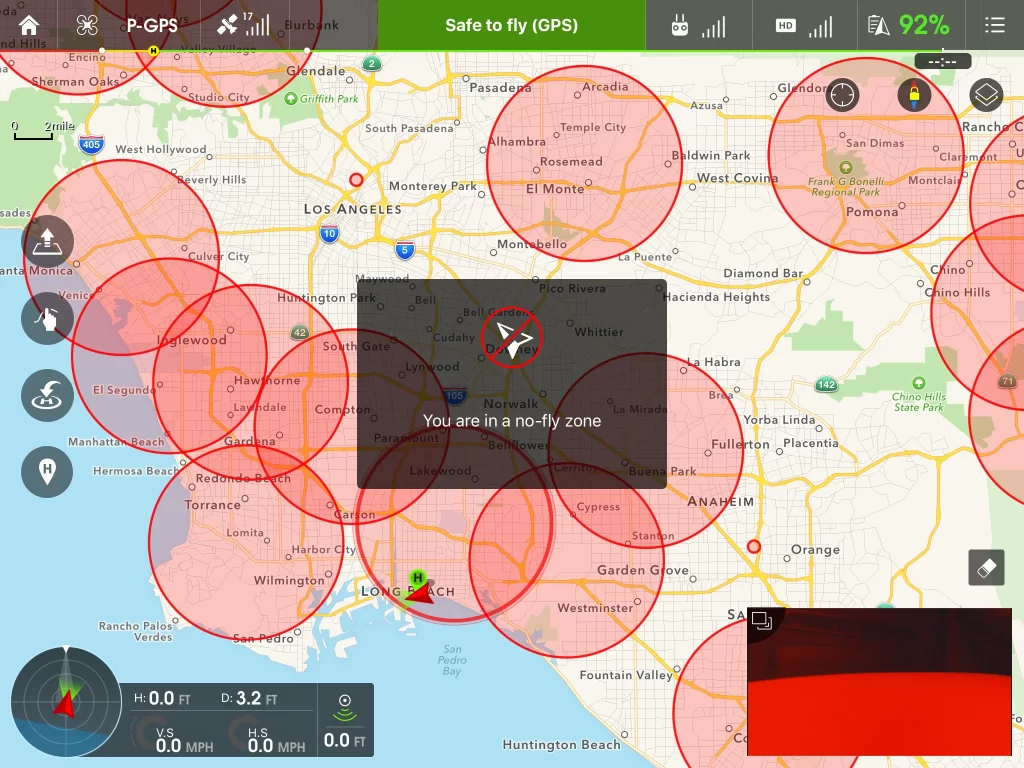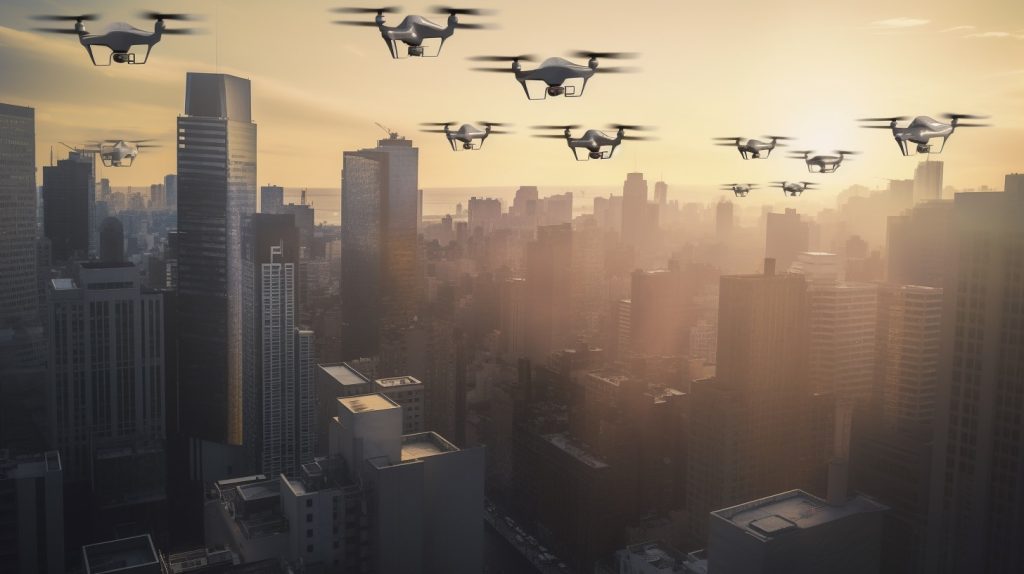Geofencing on Drones has led to a division within the drone community, with proponents and opponents each presenting compelling arguments. This article will explore these perspectives later on. For now, let’s delve into the essence of geofencing.
Geofencing involves implementing virtual limitations on drones, a concept that has sparked contrasting views within the drone community. Supporters and critics both offer strong justifications for their positions. This article will delve into these arguments later. For now, let’s clarify what geofencing entails.
Geofencing is the application of virtual constraints on drones through a blend of Global Positioning Satellites, WiFi, Radio Frequency Identification, and onboard drone software. It serves as a safety protocol by limiting entry to designated zones. These restricted areas are visible on your drone app, which promptly notifies you when approaching them.
Geofencing acts like an invisible barrier, preventing drones from entering restricted zones and causing them to hover in place. Regulatory bodies like the FAA endorse this approach. However, some drone enthusiasts perceive it as unwarranted interference with their recreational activity. Is geofencing a safety tool or an instance of government control?
The truth lies somewhere in the middle.
How to Set Up Drone Geofencing System?
The use of drones is becoming increasingly popular for various applications, from photography to delivery services. However, the potential for misuse of drones also raises growing concerns. To ensure the safety of people and property, many drone operators turn to geofencing systems to limit the range of their drones. Here is a guide on setting up a geofencing system for your drone.
Firstly, you will need to acquire a geofencing system. There are many available systems, so it’s important to research different options and choose one that suits your needs. Once you’ve selected a system, you’ll need to install it on your drone. This typically involves connecting the system to your drone’s controller and downloading the necessary software.
Next, you’ll need to configure the geofence parameters. This will involve defining the boundaries of the area where your drone is allowed to fly. You can do this by entering the coordinates of the area into the system’s software. You can also set up a virtual fence that creates an invisible barrier your drone can’t cross.
Finally, you’ll need to test the system to ensure it works correctly. You can do this by flying your drone within the configured zone and making sure it doesn’t cross the boundaries. If it does, you’ll need to adjust the parameters until the system functions properly.
By following these steps, you’ll be able to set up a geofencing system for your drone and ensure its safe and responsible use.
Understanding the Benefits of Drone Geofencing Systems
In recent years, the use of drones has become increasingly popular for a wide range of applications, from aerial photography to delivery services. However, the potential for unauthorized drone use has also raised growing concerns. To address this issue, many companies are turning to drone geofencing systems to ensure safe and responsible drone usage.
A geofence is a technology that utilizes GPS or Radio Frequency Identification (RFID) to create a virtual boundary around a specific area. When a drone enters this boundary, it triggers a warning that can be used to take action, such as sending an alert message or disabling the drone. This technology can be used to prevent drones from entering restricted zones, such as airports, military bases, or other critical locations.
The advantages of using drone geofencing systems are numerous. Firstly, it can help ensure the safety of people and property by preventing drones from entering restricted areas. Additionally, it can reduce the risk of collisions between drones and other aircraft, as well as minimize property damage caused by drones.
Moreover, geofencing can be used to protect privacy by preventing drones from intruding on private property. This can be particularly valuable for businesses that need to safeguard confidential information or sensitive data.
Lastly, geofences can also be utilized to ensure compliance with local regulations. By setting up a geofence around a specific area, businesses can ensure that their drones operate within legal boundaries.
Overall, drone geofencing systems offer a range of benefits for both businesses and individuals. By promoting safe and responsible drone use, geofences can help protect people, property, and privacy.
Understanding Geofencing on Drones
Addressing these issues, many drone manufacturers have implemented geofencing systems designed to restrict drone movement in specific areas. While these systems can be effective in certain cases, they also come with significant limitations.
One major limitation of geofencing systems is their effectiveness is only as accurate as the data used to create them. If the data is inaccurate or outdated, the system may fail to accurately restrict drone movement. Additionally, geofencing systems cannot account for changes in the environment, such as new buildings or obstacles that may be present. This can lead drones to enter areas they shouldn’t be in, potentially resulting in accidents or damage.
Another limitation is that geofencing systems cannot account for malicious intent. If a drone operator intends to enter a restricted zone, they can disable the geofencing system. This can again lead drones into areas they shouldn’t be in, potentially causing accidents or damage.
Finally, geofencing systems cannot consider the behavior of other drones. If a drone is operating in an unrestricted zone, it may still enter a restricted zone if another drone is operating there. This can once again lead drones into areas they shouldn’t be in, potentially causing accidents or damage.
Overall, while geofencing systems can be effective in some cases, they also come with significant limitations. Drone operators need to be aware of these limitations and take measures to ensure their drones do not enter areas they shouldn’t be in.
Pilot Accountability
Geofencing offers key advantages, starting with pilot accountability. Authorities monitor drones to ensure adherence to restrictions. Accidents or breaches trigger rapid responses, allowing tracking of both drone and pilot.
Incursions into restricted zones, like airports or military bases, are common.
Pilots seeking lifted restrictions must comply and provide details, fostering an accountable culture.

What Are the Drawbacks of Drone Geofencing?
Apart from the advantages, there are also drawbacks associated with geofencing, and critics of this practice have voiced their opposition vocally.
Critics raise valid concerns, and here’s the opposing viewpoint:
Delayed Response Time for Actions
Opponents argue that geofencing imposes a delay in drone actions. For instance, in search and rescue missions, waiting for approval to access certain areas can significantly impede response time. This delay might compromise performance and lead to failed rescue operations. While proponents claim that authorities will have pre-approval for such missions, this concern remains valid.
Arbitrary Restrictions
Consumers find fault in the arbitrary nature of geofenced zones. Some areas could be off-limits for drone flights without apparent reason. This restriction might hinder hobbyists, especially those residing near geofenced regions like military bases. The notion of a virtual boundary encroaching on personal rights is unsettling. After all, flying a drone a mere 10 feet above the ground is unlikely to cause harm.
Compromised Freedom of Flight
One of the joys of drone piloting is the freedom it offers for exploration. However, geofencing limits threaten this experience. As sensitive locations become geofenced, the risk of drones unintentionally entering restricted areas increases. This could negatively impact user satisfaction, leading to resistance.
Geofencing Availability
Most major drone manufacturers have incorporated geofencing into their models. DJI, for example, strongly supports geofencing across its drone lineup. Nonetheless, drones without geofencing exist, and users can also modify drones to exclude this feature.
Pros and Cons of Geofencing
As drones continue to gain popularity, authorities emphasize geofencing for pilot accountability and airspace safety. However, there’s pushback against this approach, with options to create non-geofenced drones available.
Best Drones with Geofencing
If geofencing isn’t a concern, DJI stands out as an industry leader with exceptional drone offerings. Known for pioneering technology, DJI drones like the Mavic 2 and Phantom 4 Pro offer stability, framerate, software support, and hardware excellence that few competitors match.
Do All DJI Drones Actually Have Geofencing?
DJI emerged as an early and enthusiastic advocate of the Geofencing initiative, playing a prominent role in its support. Every DJI drone incorporates inherent geofencing capabilities. To fly your drone in specific zones, you’re required to request access through your distinct ID. In certain sensitive locations, your drone’s takeoff would be restricted.
DJI maintains its reputation for offering the finest drones in the sector. However, if geofencing poses an issue, your options might be limited. Furthermore, DJI drones are designed to alert you when approaching a geofenced area and prohibit entry into such zones.
Does the DJI Mavic Air 2S come equipped with geofencing technology?
All DJI drones, including the Mavic Air 2, are equipped with integrated geofencing capabilities. These functionalities are designed to uphold safety standards and comply with regulations.
DJI maintains a strong commitment to airspace safety and guarantees that every drone they produce is equipped with effective geofencing features, functioning seamlessly.
Which Drones Offer Unrestricted Flying?
For those seeking drones without geofencing, there’s a diverse range of excellent options available. Autel stands out as a prominent player in the realm of drones without geofencing features.
While Autel has taken steps to adhere to certain geofencing regulations in the US, they haven’t implemented strict enforcement yet. As a result, their drones remain fully functional even in sensitive zones, with users receiving notifications about the drone’s location.
Here is a selection of drones that provide the freedom of unrestricted flight, catering to individuals who prefer a less constrained experience.
- Skydio 2+
- Autel Evo 2
- Yuneec Typhoon Q500
- GDU 02
Does Autel Evo 2 Have Geofencing?
Autel has introduced firmware updates that incorporate geofencing capabilities into its drone lineup.
Specifically, the Autel Evo 2 series now includes geofencing features applicable in select countries. However, it’s important to note that these restrictions are not actively enforced; rather, they serve as alerts to users entering sensitive zones.
Drone regulations vary across different regions, and there are situations where geofencing may not be a concern. To access a comprehensive drone law map, you can refer to this resource.
Conclusion – Our Thoughts on Geofencing
In summary, our perspective on geofencing is clear. It stands as a crucial tool for drone safety, and its prominence is poised to increase in the future. Nevertheless, its effectiveness hinges on educating users about its necessity. While workarounds to bypass geofencing checks may persist, the true strength lies in fostering a culture of safety and responsible flying within the drone community.
Until that shift occurs, we wish you safe and successful flights!


